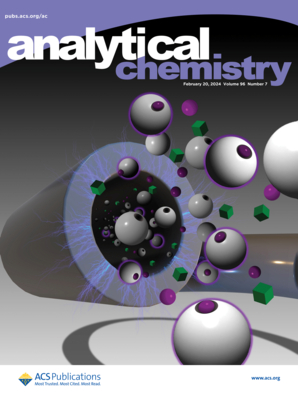Rational Design of Organelle-Targeting/Migration Fluorescent Probes via Bidirectional Regulatory Strategies and Computational Simulations.
IF 6.7
1区 化学
Q1 CHEMISTRY, ANALYTICAL
引用次数: 0
Abstract
The establishment of organelle-targeted and inwardly migratable fluorescent probes is important for studying apoptosis mechanisms and understanding the process. By fine-tuning the precise localization of the probes and their migration from the mitochondria to the nucleus, it is possible to image changes in organelle dynamics and the entire apoptotic process. However, existing probes lack a universal design strategy to image the dynamic behavior of organelles at all stages of apoptosis with high specificity, and methods still face significant challenges in resolving the molecular mechanisms of probe migration at the atomic scale. Here, a carbazole backbone platform (Car-X) for fluorescent probes was constructed by organelle-targeting methods and computational simulations. The relevant physical parameters verified the feasibility of the Car-X design. Through the bidirectional regulation strategy of "multivalency principle" and hydrophilic/hydrophobic design, Car-X achieves specific targeting to the cell membrane, mitochondria and nucleus, as well as the shift of mitochondria to nucleus migration when mitochondria are damaged. In addition, the visualization of Car-X on the three organelles facilitates the presentation of different stages of apoptosis in the simulation of intelligent biological processes. This strategy of bidirectional modulation of fluorescent probes by computationally assisted simulations provides new ideas for the design of organelle optical probes, which is expected to advance the research in organelle-related fields.基于双向调控策略和计算模拟的细胞器靶向/迁移荧光探针的合理设计。
建立细胞器靶向和可内迁移的荧光探针对于研究细胞凋亡机制和了解细胞凋亡过程具有重要意义。通过微调探针的精确定位及其从线粒体到细胞核的迁移,可以成像细胞器动力学和整个凋亡过程的变化。然而,现有探针缺乏一种通用的设计策略来高特异性地成像细胞凋亡各阶段细胞器的动态行为,并且在原子尺度上解决探针迁移的分子机制方面仍然面临重大挑战。本文通过细胞器靶向方法和计算模拟构建了咔唑荧光探针骨架平台(Car-X)。相关物理参数验证了Car-X设计的可行性。Car-X通过“多价原理”的双向调控策略和亲/疏水设计,实现了对细胞膜、线粒体和细胞核的特异性靶向,以及线粒体受损时线粒体向细胞核迁移的转变。此外,Car-X在三种细胞器上的可视化有助于在模拟智能生物过程中呈现细胞凋亡的不同阶段。这种通过计算辅助模拟双向调制荧光探针的策略为细胞器光学探针的设计提供了新的思路,有望推动细胞器相关领域的研究。
本文章由计算机程序翻译,如有差异,请以英文原文为准。
求助全文
约1分钟内获得全文
求助全文
来源期刊

Analytical Chemistry
化学-分析化学
CiteScore
12.10
自引率
12.20%
发文量
1949
审稿时长
1.4 months
期刊介绍:
Analytical Chemistry, a peer-reviewed research journal, focuses on disseminating new and original knowledge across all branches of analytical chemistry. Fundamental articles may explore general principles of chemical measurement science and need not directly address existing or potential analytical methodology. They can be entirely theoretical or report experimental results. Contributions may cover various phases of analytical operations, including sampling, bioanalysis, electrochemistry, mass spectrometry, microscale and nanoscale systems, environmental analysis, separations, spectroscopy, chemical reactions and selectivity, instrumentation, imaging, surface analysis, and data processing. Papers discussing known analytical methods should present a significant, original application of the method, a notable improvement, or results on an important analyte.
 求助内容:
求助内容: 应助结果提醒方式:
应助结果提醒方式:


